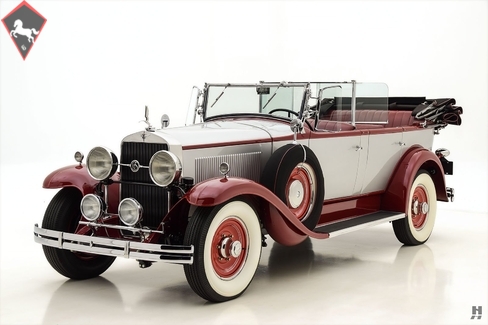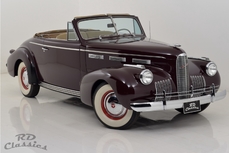La Salle 303 340 Touring 1930
General description :
General Motors chairman Alfred P. Sloan had been considering a new vehicle range to fill the ever-growing gap between Buick and Cadillac since about 1920, but it wasn’t until 1924 when Cadillac’s president Lawrence Fisher finally put that plan into motion. A key move from Fisher was to hire a talented young designer named Harley Earl to style this new car, called LaSalle. The son of a California coachbuilder, Earl was assigned the task of designing a stylish new motorcar that would convey the elegance and status of Cadillac, but with a more sporting, agile appeal, and at a more affordable price point. Earl would later reveal his original design for LaSalle was influenced by Hispano Suiza, particularly in the graceful fenders and distinct, high peaked radiator grille. LaSalle’s bold two-tone color schemes however, were all Harley Earl.
Mechanically, LaSalle utilized its own V8 engine that was similar to Cadillac’s unit albeit smaller and with a few fundamental differences. By 1930, however, LaSalle’s V8 was in essence the same size and output as the Cadillac’s, imparting the lighter LaSalle with a sporty, agile feel. It seemed that GM came along with the idea for a junior Cadillac brand at just the right time. Given the economic crash of the late 1920s, the more affordable car sold exceptionally well in its first three years, often outselling its senior sibling handily. By the end of the 1930s, LaSalle had become a serious threat to Cadillac and was stealing sales from the flagship marque, and so it was given the axe in 1940, with the Cadillac Series 60 taking over the helm as the value leader. Perhaps more importantly, it was the first major success for Harley Earl; a man who would go on to become a legend within GM and earn his place as one of the most influential automobile designers in history.
This 1930 LaSalle Series 40 wears a rare and attractive 7-passenger Fleetlands touring car body by Fleetwood. Just 239 examples of this Fleetwood style (catalog number 4057) were built, compared to more than 3,100 Town Sedans, making it quite rare today. With a well-preserved older restoration, this LaSalle is a great looking example that is well-suited for touring and regular enjoyment. In keeping with Harley Earl’s original design brief, this car is finished in a bold two-tone color scheme of silver over burgundy fenders and feature lines with subtle red striping. Paint quality is very good, showing a few minor touchups upon close inspection, but remaining very attractive overall. The body presents well with straight, properly aligned panels and clean reflections. It rides on a set of color-keyed disc wheels, with dual side mount spares giving the car a sporting and purposeful look. The brightwork shows in fine condition, and the body is well accessorized with a pair of steerable Pilot Ray driving lamps, a heron mascot (available on both Cadillac and LaSalle ranges), dual side mount spares with mirrors and a large painted metal trunk. Harley Earl’s styling of the fenders and grille combine with Fleetwood’s expertly judged body to produce a very handsome and sporty touring car.
Interior trim is very nicely presented in red antiqued leather to complement the exterior livery. Generously sized wind wings are mounted to the front screen, while rear passengers have their own windscreen with fold out wind wings and a clever sliding central panel that opens to allow them to converse with the driver. A pair of folding jump seats allows for two additional passengers, and of course the black canvas top can be folded for the full open-air motoring effect. The instrument panel is in good condition, with original dials supplemented with later-addition temperature and amp gauges to keep a watchful eye on underhood vitals.
The LaSalle V8 is nicely detailed and presented in mainly correct finishes, very suitable for a high-quality driver. The chassis and undercarriage are exceptionally clean and tidy, showing the car has enjoyed light and careful and use since its restoration. It runs and drives well, with the typical smooth power delivery and respectable performance for which LaSalle was so well known. This handsome and rare automobile is a fine example from this short-lived, but no less historically important marque; one that launched the career of Harley Earl, helped save Cadillac during the Great Depression, and inspired the likes of Packard and Lincoln to create their own entry level lines. With its handsome and rare Fleetwood coachwork and eye-catching presentation, this LaSalle Series 40 would make a fine choice for local shows and casual touring with family and friends.
https://hymanltd.com/vehicles/6048-1930-lasalle-series-340-touring/
1930 La Salle 303 340 Touring is listed sold on ClassicDigest in St. Louis by Mark Hyman for $78500.
Car Facts
Car type : Car Make : La Salle Model : 303 Model Version : 340 Touring Engine size : 0.0 Model Year : 1930 Sub type : Station wagon Location : Missouri
Sold
Seller Information
Sold
People who viewed this La Salle 303 also viewed similar La Salle listed at ClassicDigest
Other cars listed for sale by this dealer
About La Salle
LaSalle, the stylish sibling in the General Motors family, born to complement Cadillac's elegance. Let's dive into the narrative of LaSalle cars and explore some of their most significant models along with their notable specifications.Act 1: The Genesis (1927)
In 1927, amidst the Roaring Twenties, LaSalle emerged as a response to the growing demand for luxury cars. Harley Earl, a design maestro and the visionary behind Cadillac's Art and Color Section, spearheaded the creation of LaSalle. The brand aimed to fill the gap between the mass-produced Buick and the prestigious Cadillac.
Act 2: The Debut (1929)
LaSalle made its grand entrance in 1929 with a stunning lineup. The Series 328, the inaugural model, embodied the essence of luxury and sophistication. Its sleek, streamlined design and attention to detail set it apart in the automotive landscape.
Act 3: Streamlining and Innovation (1930s)
The 1930s witnessed LaSalle's commitment to staying ahead of design trends. Streamlining became a focal point, with models like the 1934 Series 350 featuring integrated headlights and a smoother profile. LaSalle also embraced innovations such as synchromesh transmissions, enhancing driving comfort.
Act 4: Art Deco Influence (1940s)
As the automotive world transitioned to the 1940s, LaSalle's designs began to reflect the Art Deco influence of the era. The brand maintained its commitment to luxurious features, introducing models like the 1940 Series 52 with distinct styling and refined interiors.
Act 5: Post-War Evolution (1946-1954)
After a pause during World War II, LaSalle returned in 1946 with refreshed designs. The post-war era saw the brand adapting to evolving tastes. The 1948 Series 61, for example, featured a more modern look, embracing the changes in automotive aesthetics.
Act 6: The Final Bow (1954)
As the 1950s unfolded, LaSalle faced increasing challenges. In 1954, General Motors made the decision to retire the LaSalle brand. The last model, the 1954 LaSalle II Roadster, marked the end of an era.
Epilogue: Legacy and Influence
LaSalle, though short-lived, left an indelible mark on automotive design. Its commitment to style, innovation, and bridging the gap between mass production and luxury paved the way for future endeavors within the General Motors portfolio.
And there you have it, the captivating tale of LaSalle cars, a brand that brought a touch of elegance to the roads and added another layer to the rich tapestry of automotive history.








